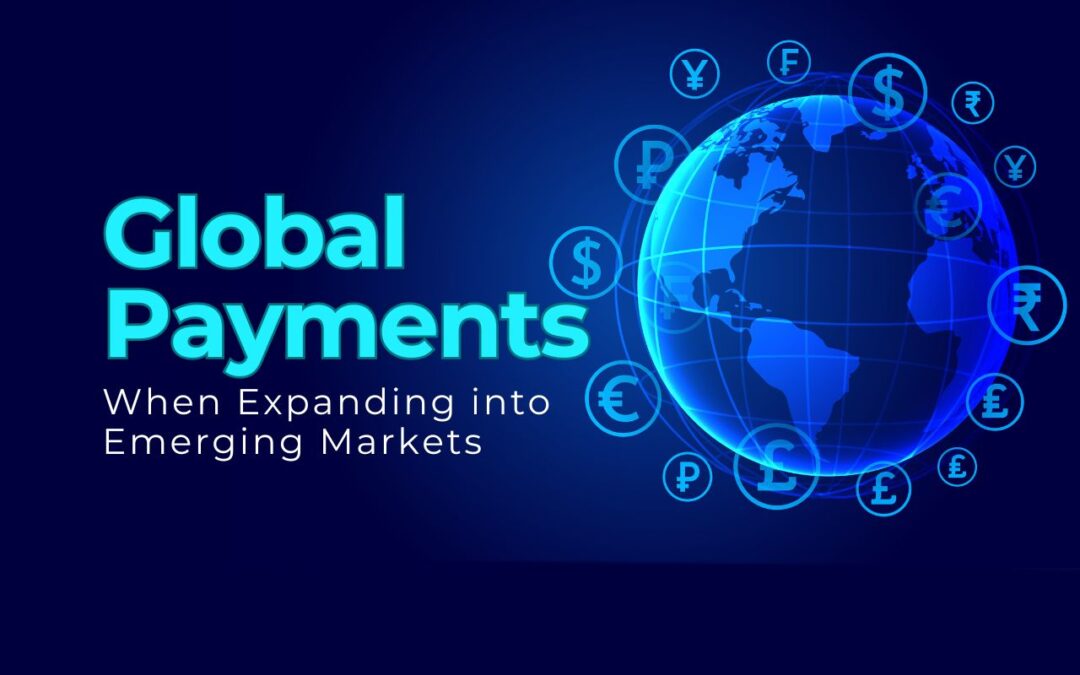Expanding into emerging markets is a strategic move that can significantly accelerate business growth. However, this expansion comes with several logistical challenges, and one of the most complex is handling global payments. Understanding how to manage cross-border transactions, currency exchanges, local payment preferences, compliance requirements, and financial risk is essential for success.
This comprehensive guide explores everything you need to know about handling global payments when expanding into emerging markets, with real-world insights, strategic tips, and recommended tools to help you navigate this critical process.
The Growing Importance of Emerging Markets
Emerging markets, such as those in Asia, Latin America, Africa, and Eastern Europe, represent some of the fastest-growing economies in the world. With increasing internet penetration, a growing middle class, and rapid digital transformation, these regions are becoming attractive destinations for international businesses.
Key Stats:
- According to the IMF, emerging markets are projected to account for nearly 60% of global GDP by 2030.
- Digital payment penetration in regions like Southeast Asia and Latin America is growing at a CAGR of over 20%.
While the opportunity is clear, success hinges on adapting to local conditions, especially when it comes to financial transactions.
1. Understand Local Payment Preferences
Each emerging market has its own payment landscape. In some areas, credit cards are common; in others, cash or mobile wallets dominate. Businesses must tailor their offerings to reflect these preferences.
Examples of Local Payment Methods:
- India: UPI, Paytm, Google Pay, PhonePe
- Brazil: PIX, Boleto Bancário
- Mexico: OXXO cash payments
- Nigeria: Paga, Flutterwave, mobile banking apps
- China: Alipay, WeChat Pay
Actionable Tip: Before expanding, conduct a market study or partner with a local consultant to identify the top three preferred payment methods for your target audience.
2. Choose the Right Global Payment Gateway
A global payment gateway acts as the bridge between your business and your international customers. Choosing the right one is critical for success in emerging markets.
Essential Features to Look For:
- Support for local payment methods
- Currency conversion and multi-currency support
- High-level encryption and security features
- Compliance with local and international financial regulations
Recommended Global Payment Gateways:
- Payoneer: Great for freelancers and small businesses in emerging markets
- Stripe: Offers extensive API integrations and supports over 135 currencies
- Adyen: Popular among enterprise-level merchants
- 2Checkout (now Verifone): Supports local payments in over 200 markets
- Rapyd: Tailored for emerging market conditions, especially in Latin America and Southeast Asia
Pro Tip: Look for platforms that offer local acquiring, which improves authorization rates and reduces fees.
3. Currency Exchange and Conversion Management
Currency fluctuations can impact your profit margins, especially in volatile economies. Understanding and mitigating foreign exchange (FX) risks is crucial.
Solutions to Manage Currency Risks:
- Multi-currency pricing: Display prices in the customer’s local currency
- Hedging strategies: Use forward contracts or options to lock in exchange rates
- Currency conversion tools: Use platforms that offer real-time, guaranteed FX rates
Example:
A business selling software subscriptions in Argentina may experience revenue fluctuation due to the volatile Argentine Peso. Using a tool like Wise Business or OFX can help stabilize income by managing exchange rates.
Strategic Tip: Keep a portion of revenues in local currency accounts to manage operational costs locally without converting at unfavorable rates.
4. Navigate Regulatory Compliance and Taxation
Compliance is one of the biggest challenges when handling global payments in emerging markets. Regulations can vary widely by country and are often subject to frequent changes.
Key Areas of Compliance:
- Know Your Customer (KYC) and Anti-Money Laundering (AML)
- Value-Added Tax (VAT) and Goods and Services Tax (GST)
- Data protection laws (e.g., GDPR, LGPD)
- Cross-border transaction restrictions
How to Stay Compliant:
- Partner with local legal experts or compliance consultants
- Use payment providers that handle tax collection and remittance
- Stay updated via government websites and financial publications
Compliance Tip: Platforms like Avalara and TaxJar can automate tax calculations and help with international tax compliance.
5. Streamline Settlements and Reconciliation
Efficient payment settlements and financial reconciliation are essential to maintain healthy cash flow, especially when dealing with multiple currencies and jurisdictions.
Best Practices:
- Use automated reconciliation software (e.g., Xero, QuickBooks, NetSuite)
- Set up multi-currency accounts to simplify fund transfers and reduce conversion losses
- Schedule regular audits to ensure transparency and prevent errors
Financial Reporting Tools:
- Xero: Great for small to medium-sized businesses with global operations
- Zoho Books: Affordable and useful for businesses in India and Southeast Asia
- Oracle NetSuite: Ideal for large enterprises with complex payment workflows
Efficiency Tip: Work with financial service providers that offer daily or weekly settlement options to accelerate cash flow.
6. Protect Against Fraud and Cybersecurity Threats
Emerging markets can be more vulnerable to fraud due to weaker regulatory enforcement and rapid digital adoption. Secure your payment processes to protect both your business and your customers.
Common Fraud Risks:
- Card-not-present (CNP) fraud
- Account takeovers
- Phishing attacks
- Synthetic identity fraud
Fraud Prevention Strategies:
- Tokenization and encryption of transaction data
- Two-factor authentication (2FA) for user logins
- AI-based fraud detection systems (e.g., Sift, Kount)
- Partner with gateways offering real-time fraud monitoring
Security Tip: Use PCI DSS-certified providers to ensure your systems meet global data security standards.
7. Collaborate with Local Financial Institutions and Fintech Partners
Local banks and fintech companies can provide invaluable insights into the payment habits of local consumers. In some cases, partnering with them is the fastest way to gain trust and ensure seamless transactions.
Benefits of Local Partnerships:
- Easier onboarding of local payment systems
- Localized customer support
- Faster settlements and lower transaction fees
Example Partnerships:
- Flutterwave in Africa
- Paystack in Nigeria and Ghana
- Ebanx in Latin America
- PayU in India and Eastern Europe
Localization Tip: Co-branding with local fintech partners can increase brand credibility and user adoption.
8. Monitor and Optimize Payment Performance Metrics
Track key performance indicators (KPIs) to evaluate the effectiveness of your global payment strategy.
KPIs to Monitor:
- Authorization rates
- Transaction success/failure rates
- Chargeback ratio
- Average transaction value
- Payment method conversion rate
Tools for Monitoring:
- Google Analytics for user behavior
- Stripe Radar for payment insights
- Adyen Control Room for real-time transaction tracking
Optimization Tip: A/B test different checkout flows, currency displays, and global payments methods to increase conversions and reduce cart abandonment.
9. Educate Your Team and Customers
Educating your internal teams and customers on how global payments work can enhance user experience and minimize errors.
Internal Education:
- Train your finance and support teams on cross-border tax rules and reconciliation
- Share best practices in handling customer payment queries
Customer Education:
- Provide clear information about available payment methods
- Share exchange rate policies and refund processes
- Offer localized FAQs and customer support
Customer Tip: Create multi-language support materials to guide users through the checkout and payment processes.
10. Plan for Future Payment Trends in Emerging Markets
Staying ahead of global payments trends ensures your business remains competitive and future-proof.
Upcoming Trends to Watch:
- Central Bank Digital Currencies (CBDCs): Pilots are underway in China, Nigeria, and India
- Blockchain-based cross-border payments
- Buy Now, Pay Later (BNPL) solutions
- Open Banking integrations
Future-Proofing Tip: Maintain flexible APIs and payment architecture that can quickly adapt to new technologies.
Final Thoughts
Successfully managing global payments is one of the most strategic aspects of expanding into emerging markets. It requires a deep understanding of local payment habits, regulatory landscapes, risk management techniques, and evolving technologies.
By leveraging the right tools, forming strategic partnerships, and continuously optimizing your payment infrastructure, your business can not only overcome financial barriers but thrive in new and lucrative markets.
Frequently Asked Questions (FAQs)
Q1: What is the best way to handle currency volatility in emerging markets?
A: Use hedging strategies, multi-currency accounts, and real-time FX rate tools to minimize risks.
Q2: How can I ensure my payment gateway supports local methods?
A: Choose gateways that offer country-specific integrations or consult local fintech partners.
Q3: Do I need to register a local entity to collect payments in another country?
A: In some countries, yes. Local banking and tax laws may require local business registration.
Q4: How do I manage tax compliance for cross-border sales?
A: Use tax automation tools like Avalara or work with local tax consultants.
Q5: What is the average fee charged by global payment processors?
A: It varies, but typically ranges from 2.5% to 4% per transaction, depending on region and volume.












